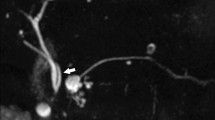Abstract
Postoperative bile leaks are difficult to diagnose because signs and symptoms are nonspecific, and definitive diagnosis requires a drainage catheter to be placed that drains frank bile or fluid that turns out bile on laboratory analysis. Hepatobiliary scintigraphy, endoscopic retrograde cholangiopancreatography (ERCP) and percutaneous transhepatic cholangiography (PTC) have been traditionally used to diagnose bile leak. Scintigraphy has poor spatial resolution and cannot localize the site of leak, ERCP may not be possible with altered postoperative anatomy and PTC is invasive and difficult to perform in the absence of dilated ducts. Recently, contrast-enhanced MR cholangiography using hepatobiliary-specific contrast media has been shown to be a noninvasive, safe way to diagnose and localize the site of bile leak in adults. We report a case of postoperative bile leak after choledochal cyst resection in a child in whom diagnosis was confirmed and the site of leak was accurately localized using gadobenate-enhanced MR cholangiography. This case demonstrates the potential of hepatobiliary-specific contrast media to diagnose postoperative bile leak and accurately localize the site of the leak in children noninvasively.



Similar content being viewed by others
References
Vitellas KM, El-Dieb A, Vaswani KK et al (2002) Using contrast-enhanced MR cholangiography with IV mangafodipir trisodium (Teslascan) to evaluate bile duct leaks after cholecystectomy: a prospective study of 11 patients. AJR Am J Roentgenol 179:409–416
Aduna M, Larena JA, Martin D et al (2005) Bile duct leak after laparoscopic cholecystectomy: value of contrast-enhanced MRCP. Abdom Imaging 30:480–487
Alegre Castellanos A, Molina Granados JF, Escribano Fernandez J et al (2012) Early phase detection of bile leak after hepatobiliary surgery: value of Gd-EOB-DTPA-enhanced MR cholangiography. Abdom Imaging 37:795–802
Thanh LN, Hien PD, Dung LA et al (2010) Laparoscopic repair for choledochal cyst: lessons learned from 190 cases. J Pediatr Surg 45:540–544
Congo K, Lopes MF, Oliveira PH et al (2012) Outcomes of choledochal cysts with or without intrahepatic involvement in children after extrahepatic cyst excision and Roux-en-Y hepaticojejunostomy. Ann Hepatol 11:536–543
Seale MK, Catalano OA, Saini S et al (2009) Hepatobiliary-specific contrast agents: role in imaging the liver and biliary tree. Radiographics 29:1725–1748
Dahlstrom N, Persson A, Albiin N et al (2007) Contrast-enhanced magnetic resonance cholangiography with Gd-BOPTA and Gd-EOB-BOPTA in healthy subjects. Acta Radiol 48:362–368
Tamrazi A, Vasanawala SS (2011) Functional hepatobiliary MR imaging in children. Pediatr Radiol 41:1250–1258
Conflicts of interest
None
Author information
Authors and Affiliations
Corresponding author
Rights and permissions
About this article
Cite this article
Chavhan, G.B., Babyn, P.S., Temple, M. et al. Diagnosis of postoperative bile leak and accurate localization of the site of leak by gadobenate dimeglumine-enhanced MR cholangiography in a child. Pediatr Radiol 43, 763–766 (2013). https://doi.org/10.1007/s00247-012-2563-3
Received:
Revised:
Accepted:
Published:
Issue Date:
DOI: https://doi.org/10.1007/s00247-012-2563-3




